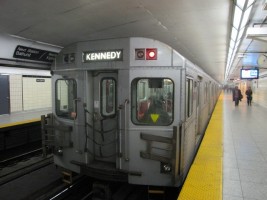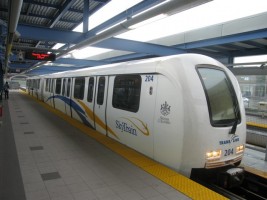 ICTS 3027
ICTS 3027
Location: Kennedy Station, Toronto, Ontario, Canada
Operator of Vehicle: Toronto Transit Commission
Date of Photo: March 12, 2007
In various parts of the transit enthusiast world, there have been people saying that if you want to ride the Scarborough Rapid Transit Line (also known as Line 3 Scarborough) of the Toronto subway system, you better do so soon, as the line is scheduled to shut down this November 18. Unfortunately, it is possible that you may have missed your chance already. The line is scheduled to close this November in order to be dismantled and ultimately replaced by an extension of Line 2 Bloor-Danforth. Currently, Line 2 ends at Kennedy, and passengers who wish to continue to Scarborough must change trains there. By the end of the decade, this trip will be a one seat ride but until then, a long term substitute bus service will provide the service between Kennedy and Scarborough.
Line 3 is unique within the Toronto transit network. The line is a “light Metro” line that was originally going to be a streetcar line operated using CLRV vehicles. However, provincial politics resulted in a decision to redesign the line to a design that was developed by a Crown corporation owned by the Ontario government, known as ICTS (Intermediate Capacity Transit System). ICTS was meant to provide service on routes that had more ridership than buses but lower ridership than traditional heavy rail lines. However, the implementation in Toronto proved to be problematic in several regards. One such example is that the trains were meant to be operated in a fully automated mode but the TTC opted to have them operate in a partial manual mode, increasing wear and tear on the vehicles and requiring additional equipment to be added to support manual operation. Another example is that the cars were found unable to handle a tight curve on the reversal loop at end of the line, ultimately resulting in the loop’s abandonment.
With the “S Series” ICTS cars that have served on Line 3 since its 1985 opening nearing the end of their useful lives, it has been decided to shut down the Scarborough RT line and extend Line 2 to Scarborough as a replacement. However, a derailment near Ellesmere Station on July 24 shut down the line and it has yet to reopen, prompting some to suggest that the line may not reopen prior to its scheduled closure in November.
Although the Scarborough RT line appears to have had a troubled and turbulent history based on this writeup, you shouldn’t think that the ICTS technology was a failure. The Vancouver SkyTrain uses the same technology and is arguably the most successful application of ICTS. The ICTS design was ultimately sold and bought by various manufacturers and improved upon over the decades. It is now owned by Alstom, known as Innovia Metro, and can be found on the AirTrain JFK in New York City, Beijing Subway, Younin EverLine in South Korea, and the Riyadh Metro.
For more photos of TTC’s Scarborough Rapid Transit Line, please click here.



